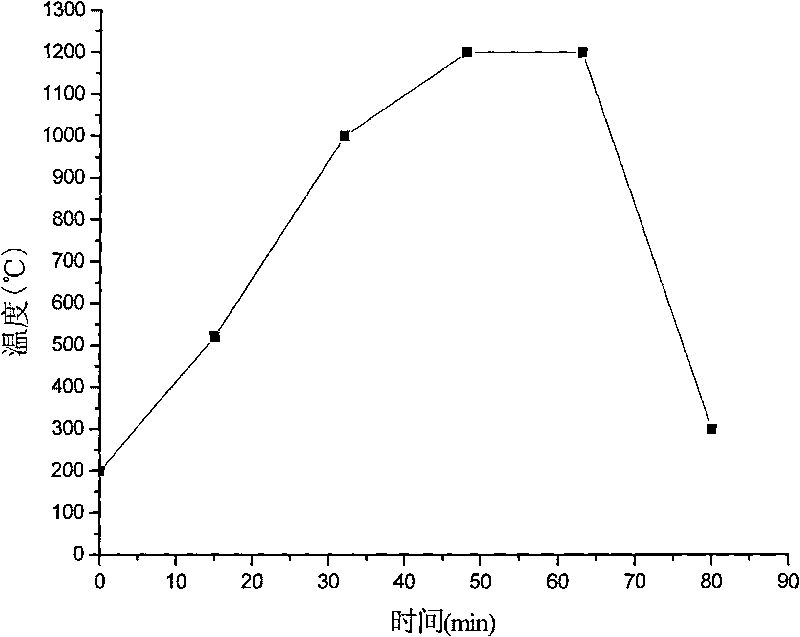Method for firing porous filtering ceramic tiles with ceramic polishing scrap
A technology for ceramic polishing waste and ceramic tiles, which is applied in the removal and application of ceramic products and solid waste, can solve the problems of complex process and high cost, and achieve the effects of low bulk density, low product cost and wide application range.
- Summary
- Abstract
- Description
- Claims
- Application Information
AI Technical Summary
Problems solved by technology
Method used
Image
Examples
Embodiment 1
[0033] Example 1: (Process flow such as figure 1 As shown, the firing curve is as figure 2 Shown)
[0034] Using polishing waste, calcined alumina, calcined talc and light magnesia as raw materials, the chemical composition of porous filter ceramic tiles is shown in Table 2. Heavy oil is used as fuel, and its heat of combustion is 41868KJ / Kg.
[0035] (1) Raw material processing: First, the polishing waste (loss on ignition is 2.01%) and calcined alumina (loss on ignition 3.99%) are coarsely crushed and sieved; then, the polishing waste is weighed 70Kg, calcined alumina 19Kg, Combine 35Kg of burnt talc and 2Kg of light magnesium oxide, add sodium tripolyphosphate (additive) which accounts for 0.5% of the total mass of the above substances; finally, put it into a ball mill for wet ball milling. The ball milling medium is alumina. The amount of ball mill The ratio is large: medium: small = 5: 2: 3, ball milling time is 20 hours, a slurry with a water content of 33% is obtained, an...
Embodiment 2
[0041] With polishing waste, calcined alumina, and calcined talc as the main raw materials, the chemical composition of porous filter ceramic tiles is shown in Table 2, and the combustion heat value of the fuel is 45218KJ / Kg.
[0042] (1) Raw material processing: firstly, coarsely pulverize the polishing waste (loss on ignition is 8.99%) and calcined alumina (loss on ignition 0.10%) and sieving; then, weigh the polishing waste 50Kg, calcined alumina 22Kg and Combine 28Kg of burnt talc and add sodium tripolyphosphate (additive) which accounts for 0.5% of the total mass of the above raw materials; finally, put it into a ball mill for wet ball milling. The ball milling medium is alumina, and the dosage ratio of the ball mill is large: medium: Small=5:2:3, the ball milling time is 22 hours, the slurry with a water content of 33% by mass is obtained, the sieve residue is less than 0.1% (mass percentage), and the flow time is 34s in the coating 4 viscosity cup;
[0043] (2) Powder prepar...
Embodiment 3
[0048] With polishing waste, calcined alumina, calcined talc and light magnesia as the main raw materials, the chemical composition of the porous filter ceramic tile is shown in Table 2. The combustion heat value of the fuel is 43318KJ / Kg.
[0049] (1) Raw material processing: firstly, coarsely pulverize polishing waste (loss on ignition: 4.63%) and calcined alumina (loss on ignition: 2.99%) and sieving; then, weigh the polishing waste 60Kg, calcined alumina 18Kg, 30Kg of burnt talc and 7Kg of light magnesium oxide are mixed, and 0.3% of the total mass of the above-mentioned substances is added with sodium tripolyphosphate (additive); finally, it is put into a ball mill for wet ball milling, the ball milling medium is alumina, and the amount of ball mill The ratio is large:medium:small=5:2:3, the ball milling time is 25 hours, the slurry with a water content of 32% is obtained, the sieve residue is 0.5% (mass percentage), and the fluidity is in the outflow time of the 4 viscosity ...
PUM
| Property | Measurement | Unit |
|---|---|---|
| heating value | aaaaa | aaaaa |
| heating value | aaaaa | aaaaa |
| porosity | aaaaa | aaaaa |
Abstract
Description
Claims
Application Information
 Login to View More
Login to View More - R&D
- Intellectual Property
- Life Sciences
- Materials
- Tech Scout
- Unparalleled Data Quality
- Higher Quality Content
- 60% Fewer Hallucinations
Browse by: Latest US Patents, China's latest patents, Technical Efficacy Thesaurus, Application Domain, Technology Topic, Popular Technical Reports.
© 2025 PatSnap. All rights reserved.Legal|Privacy policy|Modern Slavery Act Transparency Statement|Sitemap|About US| Contact US: help@patsnap.com



